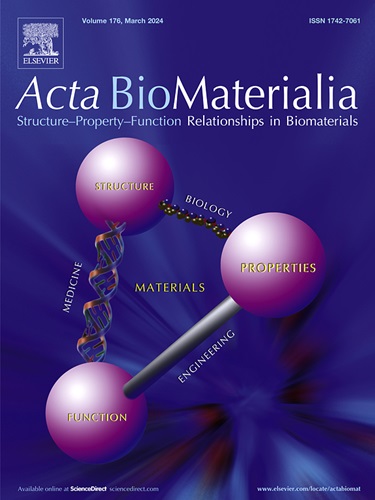与留置和植入式生物电子医疗器械的生物反应有关的临床挑战和机遇。
IF 9.4
1区 医学
Q1 ENGINEERING, BIOMEDICAL
引用次数: 0
摘要
几十年来,植入式电极一直被用于刺激、感知或监测各种生物过程,从葡萄糖监测装置到人工耳蜗植入体,不一而足。虽然与电极应用相关的基础科学已经是一个成熟的领域,但临床前和临床研究表明,由于缺乏对组织-材料界面相互作用的控制,尤其是在较长的时间范围内,体内电极的应用仍面临重大挑战。在此,我们将讨论植入式电极和相关生物电子界面在临床应用中目前面临的挑战和机遇,重点关注新兴技术以及生物污损、微生物定植和异物反应等障碍。预计克服这些挑战将为新一代植入式医疗设备打开大门,并产生重大的相关临床影响。意义说明:几十年来,植入式电极一直被用来刺激、感知或监测各种生物过程,从葡萄糖监测设备到人工耳蜗植入体,不一而足。下一代生物电子植入式医疗设备有望带来爆炸性的新应用,而在此之前,这些应用是不可能实现的。然而,一些长期存在的生物学难题阻碍了这些新应用的实现。我们从临床角度介绍了这些生物挑战是如何影响器械市场和临床试验格局的。具体来说,我们介绍了当前器械应用的统计分类,并讨论了生物污损、异物反应和微生物定植是探索新一代器械之前需要解决的主要因素。本文章由计算机程序翻译,如有差异,请以英文原文为准。

Clinical challenges and opportunities related to the biological responses experienced by indwelling and implantable bioelectronic medical devices
Implantable electrodes have been utilized for decades to stimulate, sense, or monitor a broad range of biological processes, with examples ranging from glucose monitoring devices to cochlear implants. While the underlying science related to the application of electrodes is a mature field, preclinical and clinical studies have demonstrated that there are still significant challenges in vivo associated with a lack of control over tissue-material interfacial interactions, especially over longer time frames. Herein we discuss the current challenges and opportunities for implantable electrodes and the associated bioelectronic interfaces across the clinical landscape with a focus on emerging technologies and the obstacles of biofouling, microbial colonization, and the foreign body response. Overcoming these challenges is predicted to open the door for a new generation of implantable medical devices and significant associated clinical impact.
Statement of significance
Implantable electrodes have been utilised for decades to stimulate, sense, or monitor a broad range of biological processes, with examples ranging from glucose monitoring devices to cochlear implants. Next-generation bioelectronic implantable medical devices promise an explosion of new applications that have until this point in time been impossible to achieve. However, there are several persistent biological challenges hindering the realisation of these new applications. We present a clinical perspective on how these biological challenges have shaped the device market and clinical trial landscape. Specifically, we present statistical breakdowns of current device applications and discuss biofouling, the foreign body response, and microbial colonisation as the main factors that need to be addressed before a new generation of devices can be explored.
求助全文
通过发布文献求助,成功后即可免费获取论文全文。
去求助
来源期刊

Acta Biomaterialia
工程技术-材料科学:生物材料
CiteScore
16.80
自引率
3.10%
发文量
776
审稿时长
30 days
期刊介绍:
Acta Biomaterialia is a monthly peer-reviewed scientific journal published by Elsevier. The journal was established in January 2005. The editor-in-chief is W.R. Wagner (University of Pittsburgh). The journal covers research in biomaterials science, including the interrelationship of biomaterial structure and function from macroscale to nanoscale. Topical coverage includes biomedical and biocompatible materials.
 求助内容:
求助内容: 应助结果提醒方式:
应助结果提醒方式:


